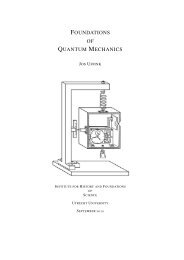Subjective probability and statistical physics
Subjective probability and statistical physics
Subjective probability and statistical physics
Create successful ePaper yourself
Turn your PDF publications into a flip-book with our unique Google optimized e-Paper software.
4.3 Jaynes’ Maximum Entropy Principle<br />
In 1957 Edwin Jaynes proposed a much more extensively developed subjective approach<br />
to <strong>statistical</strong> <strong>physics</strong>, which, however, is also more controversial, also among<br />
fellow subjectivists. His adherence to a subjective view on <strong>probability</strong> is quite explicit.<br />
But he resisted a personalist interpretation of this concept, as expounded by<br />
Ramsey <strong>and</strong> De Finetti (cf. (Jaynes 1968)). Instead, his approach is closer to the<br />
classical view, in the sense that he considered it a definite desideratum that rational<br />
minds in the possession of the same information should assign the same probabilities.<br />
His major claim to fame is that he designed a principle to deal with import of observational<br />
data that is quite different from the Bayes-Laplace view, <strong>and</strong> generalizes the<br />
Principle of Insufficient Reason.<br />
Maximum Entropy Principle: Suppose in a given situation there<br />
are exactly n possible (mutually exclusive) events or states of a physical<br />
system. Our goal is to pick a <strong>probability</strong> distribution p = (p 1 , . . . , p n )<br />
from the set S of all <strong>probability</strong> distributions with n entries. suppose<br />
further that all the information we have concerning the system or events<br />
is encapsulated into a constraint C that can be modelled as allowing only<br />
a subset C ⊂ S from the space of all <strong>probability</strong> distributions. Then<br />
the appropriate choice for p, given the information we possess, is the<br />
distribution p ∈ C that maximize the Shannon entropy<br />
H(p) =<br />
n∑<br />
p i log p i . (12)<br />
i=1<br />
Clearly, in the simple case where we have no information beyond the fact that there<br />
are n possibilities, i.e. when C = S, this principle immediately leads to the choice<br />
p = (1/n, . . . , 1/n). This means that it contains the old principle of insufficient reason<br />
as a special case. However, it goes much further than that since it also prescribes a<br />
choice of p when we do have information that may favour one outcome above another.<br />
It is easy to show that there is, in fact, a unique distribution that maximizes the<br />
expression (12) as long as the constraint set C is convex, as is usually the case.<br />
Extensions of this principle to the case where the number of possibilities are<br />
countably or uncountably infinite involve much more work, which I will skip in this<br />
context (see (Uffink 1995) for details).<br />
However, I would like to dwell on the worry whether the MEP is compatible with<br />
Bayesian procedures. The issue is subtle, <strong>and</strong> I won’t go into all aspects of the debate<br />
(see (Uffink 1996, Caticha & Giffin 2006) for details <strong>and</strong> references) except to point<br />
out the basic grounds of this worry.<br />
The problem is, in essence, where the constraint comes from or what it represents.<br />
Note that, according to Jaynes’ point of view, <strong>probability</strong> distributions represent epistemic<br />
judgments, <strong>and</strong>, therefore, to adopt a constraint C ⊂ S, means that we decide<br />
that our actual judgment should belong to some subset of all possible epistemic judgments.<br />
At first sight, this suggests that the constraint represents information about<br />
our own epistemic judgment. However, Jaynes often thinks of such a constraint as<br />
empirical information (his term is “testable information”). Typically, this information<br />
takes the form of data about the occurrence of some event, or a sequence of<br />
16
















